In New York City, bagels and lox are not only an iconic breakfast pairing, but a direct reflection of how immigrants from different parts of the world have created dishes people now consider to be distinctly American.
Many food historians agree that bagels originated Poland, but the combination of salty salmon plus cream cheese on a bagel was born in the City that Never Sleeps. On the latest episode of his TODAY All Day streaming series "Family Style," Al Roker explores the history behind a food combo born from Jewish roots, transformed by new generations and beloved by millions around the world.
Al first stopped at the iconic Lower East Side appetizing shop Russ & Daughters. Now run by cousins Niki Russ Federman and Josh Russ Tupper, who are fourth-generation co-owners, the purveyor of gourmet smoked fish is a local legacy. It's survived two World Wars, two pandemics and remained open as a beacon of hope as New York rebuilt after 9/11. Today, the store still boasts lines around the block as hungry patrons wait to sample their signature hand-sliced smoked salmon and a variety of cream cheese flavors.
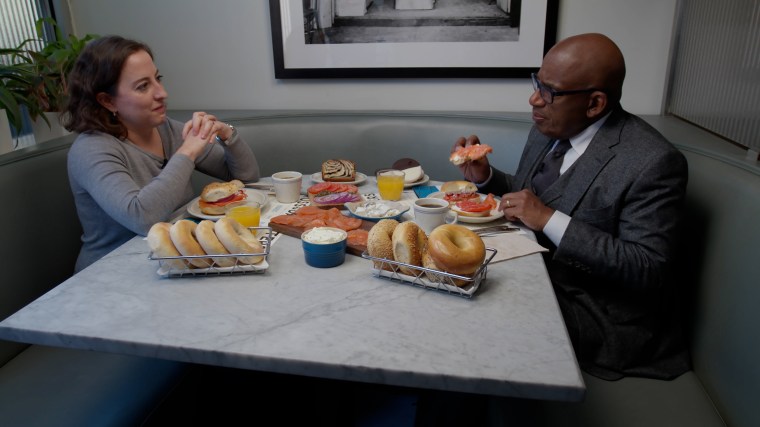
Russ & Daughters was founded by Joel Russ, who immigrated to the U.S. from Poland in 1907. His journey began on the Lower East Side (just steps from the current store location) selling schmaltz herring out of a barrel.
"After Ellis Island, this (the Lower East Side neighborhood) was the starting off point for the majority of poor, Jewish immigrants. This is where they landed and they got their start. And so he was just feeding basic food to other poor immigrants like himself," Federman told TODAY.
By 1914, Russ opened his first brick-and-mortar shop: it: J. Russ National Appetizing. Russ and his wife, Bella, had three daughters, Patty, Ida and Anne, the youngest of whom is Federman and Tupper's grandmother. When each girl turned 11, they began working in the shop, learning all aspects of how the business was run. In 1935, Russ made all three of his daughters his official business partners and changed the name to Russ & Daughters. It became the first business in the U.S. to recognize " and daughters" in its title.
"Justice Ruth Bader Ginsburg was a good customer of ours," Federman told Al. "Her family came from the Lower East Side. And she once said that before she knew the word 'feminist,' when she looked at up at the sign 'Russ & Daughters,' she understood that women could have an impact."
Russ may have been an unlikely feminist when he started his shop in the early 1900s, but both of his grandchildren agree that he was certainly a great businessman.
"Russ and Daughters is the torch bearer of what's called 'appetizing.' And this is a food tradition born here in New York. And it's the sister food tradition to delicatessen, both of which come up through the Jewish culture dietary rules to separate fish and dairy from meat," explained Federman. "So a delicatessen, strictly speaking, is for meat. The appetizing store is where you go for fish and dairy, things like herring, smoked fish."
So who was the first person to actually put smoked salmon and cream cheese on a bagel?
According to food historian and professor Jacob Remes, who teaches at New York University's Gallatin School of Individualized Study, the exact origins of the iconic breakfast combo are hard to trace, but explained that the nexus is clearly linked to Jewish Americans' struggle to maintain their food traditions while living in overcrowded tenement buildings at the turn of the century.
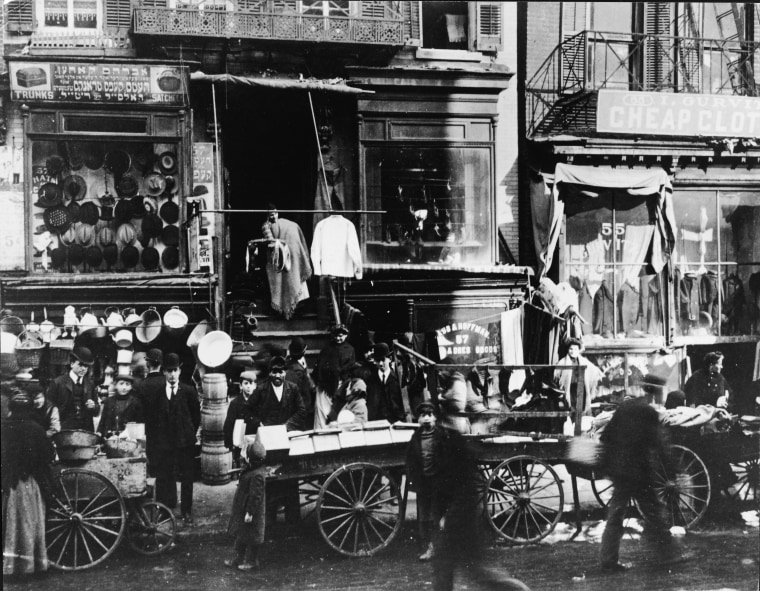
"One of the things about Lower East Side Jewish food is that a lot of food wasn't made at home," Remes told TODAY. "When you don't have running water and when you don't have electric or gas stoves, it's really hard to do very much cooking."
Women who were responsible for feeding their families often bought food from push carts and bakeries.
"Jews from large areas of the Russian Empire are all coming and mixing and sharing their food traditions and then also figuring out what their food traditions are going to be in the United States, what it means to be an American Jew and eating American Jewish food," Remes said.
Cured salmon was introduced to New Yorkers from Nova Scotia, where culinary prep methods were similar to those used in Eastern Europes during its iciest seasons. Cream cheese was invented in the U.S. during the late 1800s and bagels come from Jewish baking traditions in Poland.
While many think of lox today as any type of smoked salmon, the original version of the sandwich used belly lox, which is cured in salt (without smoking) to preserve fish without refrigeration. It's incredibly salty so it needs tangy cream cheese to make it more palatable. Plus, the combo of fatty fish and cream cheese provided a filling meal that didn't require any cooking, meaning observant Jews could enjoy it on the Sabbath. Key to observing the fundamental Laws of Shabbos (the Jewish day of rest) is avoiding hard labor, including cooking with most types of heat from sundown on Friday night to sundown on Saturday night.
Signature to Russ & Daughter's is its premium smoked salmon with a high fat content that's sliced so thinly it takes new employees up to six months of training to master the technique. Some of their products are sourced from another locally owned company focused on New York's famed cured catch: Acme Smoked Fish. With locations in Brooklyn, New York, and North Carolina, Acme has been selling smoked fish for 115 years.
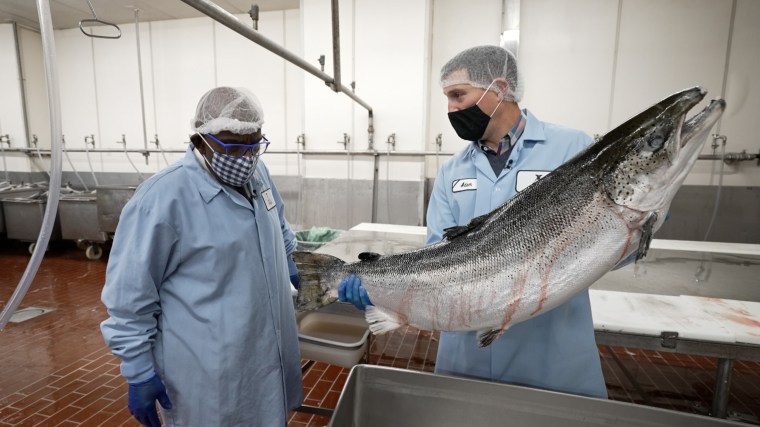
Acme's Brooklyn factory processes, smokes and packs nearly 8 million pounds of fish every year. Adam Caslow is the fourth-generation owner of Acme Smoked Fish. His grandfather, Harry Brownstein, started selling fish shortly after immigrating from Russia to Brooklyn at the turn of the century. What began as Brownstein buying fish from different local smokehouses and creating a sales route, evolved into his dream of owning a smokehouse.
Today, Caslow runs a mighty smoked fish empire — selling top-quality Atlantic salmon and other smoked fish to local favorites like Ess-a-Bagel and H&H, as well as larger retail chains, like Trader Joe's.
It can take up to five days to make smoked salmon, as each order is tailored to the buyers' preferences, from the type of fish used to the curing method. It all begins with a large (around 26-pound) farm-raised Atlantic salmon. The fish is deboned, filleted and then preserved with salt, either with a wet brine or a dry curing method. After curing for 24 hours, the salmon gets cold smoked below 85 degrees for up to 20 hours. This preserves the fish and imparts a subtle, smoky texture.
While Caslow and the Russ family are working hard to keep their family traditions alive for new generations, other restauranteurs are honoring their roots with a nod to the future of sustainability.
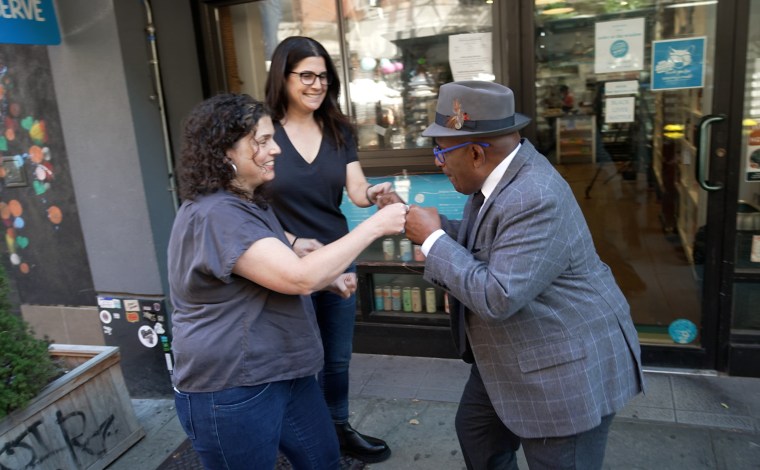
Sisters Erica and Sara Kubersky, co-owners of vegan market Orchard Grocer, are on a mission to make the Jewish dishes they loved growing up in a more sustainable way. After opening their first business, a vegan shoe shop called MooShoes 20 years ago, the Kuberskys noted how often their customers asked about where to get good vegan food.
Five years ago, they opened their own food store, offering plant-based spins on many foods typical of their Jewish background. As vegan converts in their teens, the Kuberskys knew first-hand how difficult it was to sacrifice certain foods that were integral to their cultural traditions.
Today, more and more people are going vegan for a variety of reasons, from animal welfare to health benefits.
"We're watching climate change happen right now and I think that's causing a lot of people to think twice about what they're eating and how they are contributing. So it makes sense to us that it is becoming so mainstream," Sara Kubersky told TODAY.
Orchard Grocer sells a lineup of vegan sandwiches that emulate "pastrami" Ruebens, tuna melts and, of course, bagels with cream cheese and lox. To master the nostalgia of "that feeling of home," as Sara puts it, the sisters even offer a salty lox made from cured carrots. It's served stacked high on bagel with a cashew-tofu cream cheese.
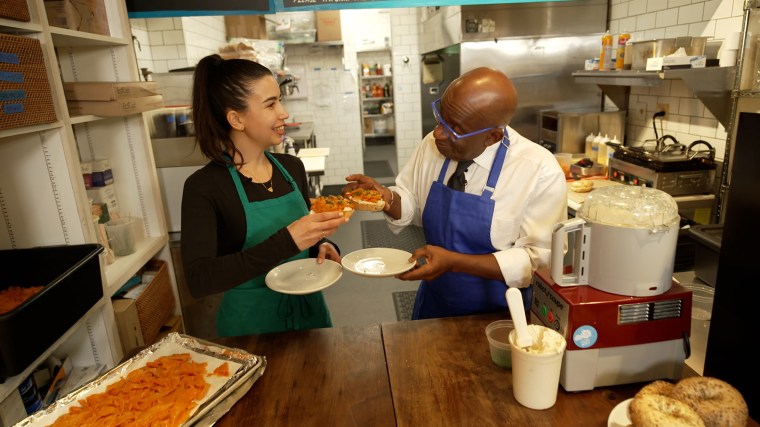
"We haven't had to give up our tradition of bagels and lox on a Sunday. We're able to have a really satisfying product," Erica said.
After helping Orchard Grocer's general manager Nora Vargas whip up the shop's secret recipe, an at-first skeptical Al was pleasantly surprised by the tasty vegan "lox."
"I think this a really terrific idea. Thank you for opening my eyes," Al said, calling the dish "the lox and bagels of the future."
"Family Style with Al Roker" airs Wednesday, December 1, at 11 a.m. and 7 p.m. ET.

